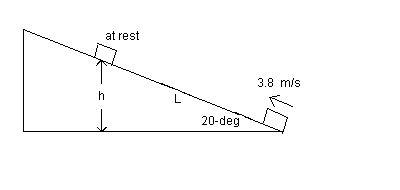
|
Solutions to real Test 2 |
Student Perfomance |
1. (25 points)
A 2.10 x 103 kg box starts at the bottom of a long driveway.
The driveway makes an angle of 20-degrees with the horizontal. At the bottom of
the incline, the speed of the box is 3.8 m/s. The coefficient of kinetic
friction between the block and the surface is µ.
The block rises a vertical distance h = 0.400 m and a corresponding
distance L along the incline before coming to rest.
Please use the conservation of energy methods of Ch. 5 in the presence of friction.
What is the coefficient of kinetic friction µ between the block and the incline?

| Solution Outline: v1= 3.8 m/s and
h = 0.400 K1 + U1 = K2 + U2 + Heat 0 + ½ mv12 = 0 + mgh +µmgcos20*L 0 + ½ mv12 = mgh + µmgcos20*h/sin20 Note that L =h/sin20 since h = Lsin20 Solve for µ = 0.306 |
2. (30 points)
A ball (of mass m1 = 1. 00 kg) rolling across a table at velocity +1.20 m/s makes an elastic head on collision with an different second ball (of mass m2 = 1. 40 kg) that moves left with velocity - 1.00 m/s. Assume motion to the right means the velocity is positive! Thus, motion to the left means velocity is negative !
(a) (5 points) What is the direction of motion of the first ball of mass m1 after the collision, to the right or left? Show all work!!
(b) (5 points) What is the direction of motion of the second ball of mass m2 after the collision, to the right or left? Show all work!!
(c) (10 points) What is the numerical value of the velocity of the first ball that you calculated in part (a) ?
(d) (10 points) What is the numerical value of the velocity of the second ball that you calculated in part (b) ?
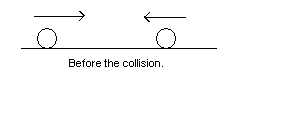
| Solution outline: Note that the masses do not cancel, so Note that v1i = 1.2 m/s and v2i
= -1.0 m/s |
3. (25 points) Three masses are situated on the
rectangle as shown below. The dimensions are given. m1 = 3 kg and m2 = 4 kg.
(a) (13 points) Find the magnitude of the net force on m3 = 1 kg.
(b) (12 points) Find the direction of the net force on m3. Please draw
the net force vector on the axis shown. Draw the vector in the correct quadrant!
(Hint: The vector does NOT point in the first quadrant.) Please try to
indicate the direction by showing the reference angle that the vector
makes with the x-axis. Thank you.
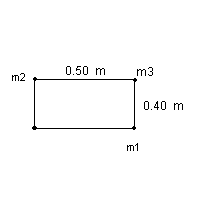
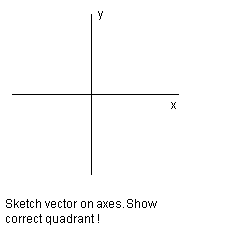
| (a) Click here
to see problem 33 of Quiz 6 for the methods used to solve this test
problem. FNET = 1.6x10-9 N after plugging in the numbers. (b) 50o = tan-1(F31/F32) |
4. ( 11 points) Extra Credit
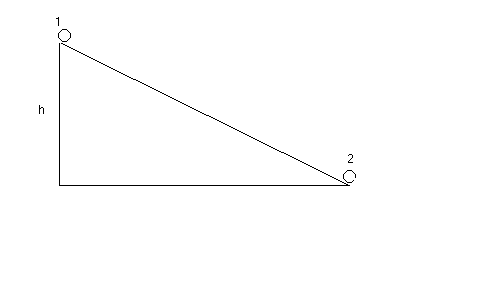
A spherical ball with I =
![]()
starts from rest at point 1 at the top of the incline. The vertical distance of
the ball is h = 1.0 m above the ground. The ball mass m = 1.0 kg . What is the
linear speed v of the ball when it reaches the bottom at
point 2 ?
| Solution Outline: Use conservation of energy, K1 + U1 = K2 + U2 0 + mgh = (1/2)mv2 + KROT + 0 KROT = ½ I (v2/r2) = ½(2/5*mr2)(v2/r2) mgh = (1/2)mv2 + ½(2/5*mr2)(v2/r2) Note that the radius r and the mass m
cancel out. (What ?!) We have use the fact that angular speed = v/r .
Solve for the speed v.
|